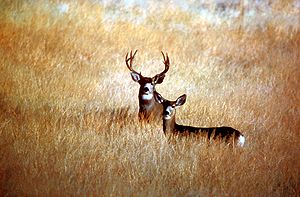 |
| (Photo credit: Wikipedia) |
The North Dakota Game and Fish Department’s fall mule deer survey indicated production in 2013 was higher than in 2012.
Biologists counted 1,761 (1,224 in 2012) mule deer in the aerial survey in October. The buck-to-doe ratio of 0.46 (0.37 in 2012) is similar to the long-term average of 0.43 bucks per doe, while the fawn-to-doe ratio of 0.74 (0.59 in 2012) was the highest since 2009, but still below the long-term average of 0.91 fawns per doe.
Bruce Stillings, big game supervisor in Dickinson, said the combination of no antlerless harvest and milder winter conditions over much of mule deer range in 2011 and 2012 has provided conditions needed to begin mule deer population recovery in the badlands.
“In addition, substantial rainfall this spring provided much improved habitat conditions for fawning this year compared to 2012,” Stillings said.
While it is encouraging to see mule deer numbers increase for the short-term, Stillings said challenges remain for continued population growth, including changes in habitat quality due to fragmentation and disturbance, predators and weather.
The fall aerial survey, conducted specifically to study demographics, covers 24 study areas and 306.3 square miles in western North Dakota. Biologists survey the same study areas in the spring of each year to determine population abundance.


No comments:
Post a Comment